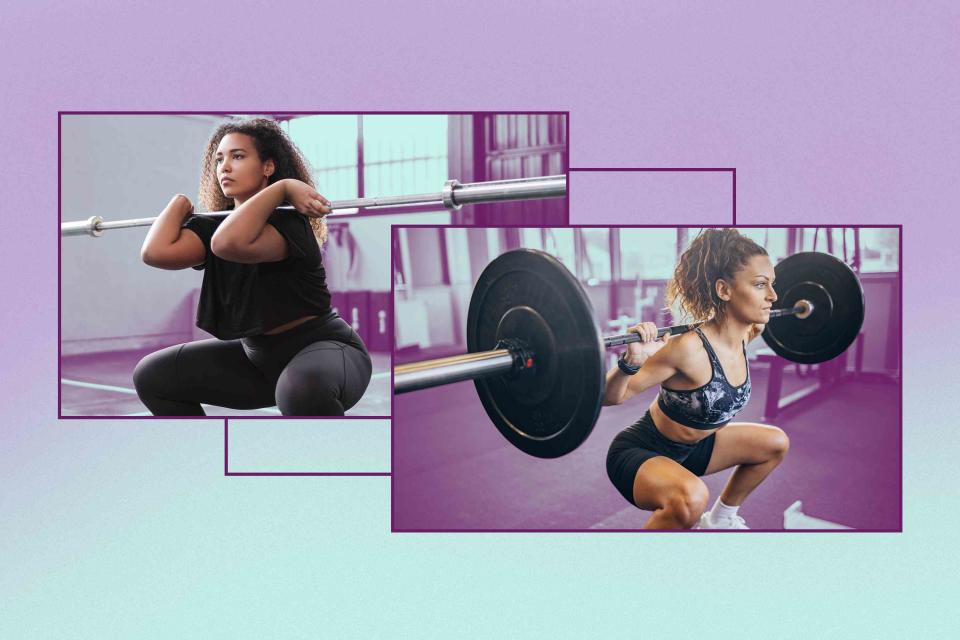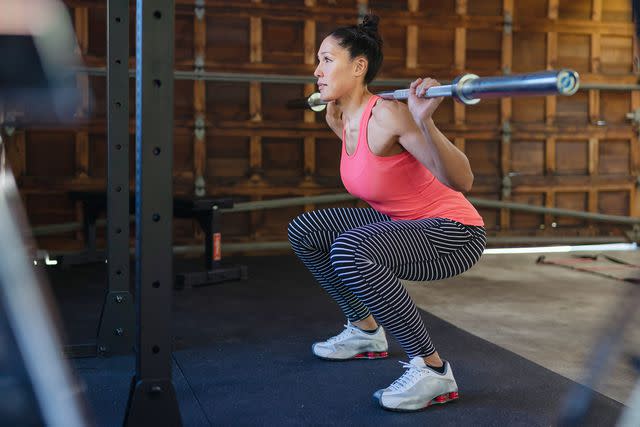Front Squat vs. Back Squat: Which Is More Effective for Strength Training?
When your goal is to build your glute strength, is a barbell front squat or back squat more effective? Here, experts break down the front squat vs. the back squat.

There are more squat variations than there are nicknames for the muscle all that squatting helps build (peach, booty, bum — you get the picture). But if putting on muscle mass or boosting strength is your prime fitness goal, then very likely your training regime includes some barbell squat variation. After all, it's much easier to go heavy when using a barbell than it is with a kettlebell or dumbbell, since you're not limited by only having certain weights available (and you can always add on an extra plate or two for more of a challenge). But which of the two main barbell squat variations is best: front squat or back squat?
Truth be told, there are more similarities between these two compound exercises than there are differences. "Both the front squat and back squat effectively and efficiently build strength throughout the body," says Jake Harcoff, C.S.C.S., C.I.S.S.N., head coach and owner of AIM Athletic. However, the different position of the barbell impacts its benefits and uses, he says.
Ahead, a full comparison between the front squat and the back squat. Read on to learn which barbell squat is better for putting on mass, which is better for beginners, and so much more.
What Is a Front Squat?
Often overlooked outside of CrossFit and Olympic lifting communities, the front squat is a barbell squat variation that requires that you maintain a front rack position while you squat. "The bar rests along your collarbone area while you sit down and then stand back up," explains Seamus Sullivan, C.S.C.S., an online performance and nutrition coach. Simply, the load is positioned along the front side of the body.

:
Benefits of a Front Squat
There are many (many!) reasons to add the front squat to your exercise line-up. Here are four of these benefits.
1. Front squats strengthen your midline.
"Both the front squat and the back squat require that you 'brace' your midline throughout the movement to keep your lower back safe," says Sullivan. However, on the front squat you have to brace your midline extra hard to keep the weight from pulling you forward, he says. "That extra activation calls on midline stabilizer muscles such as the erector spinae, multifidi, and quadratus lumborum," he says.
The result? Greater midline activation, which can lead to greater core strength gains.
:
2. Front squats work your quads.
Another muscle group that the front squat hammers? Your quadriceps, or the front of your thighs. Due to the frontward location of the bar, "front squats elicit greater activation in your quads than the back squat," says Sullivan.
You call on your quads every time you move your lower leg at the knee or upper leg at the hip, he says, so strengthening your quads can help you walk, run, jump, bike, and sit with greater ease and/or power.
3. Front squats are a full-body exercise.
Let the record show: Front squats don't just work your core and quads.
Holding the barbell in the front-rack position pulls in your upper back, forearms, shoulders, wrist, and grip muscles, says Harcoff. Meanwhile, he explains, lowering to the bottom of the squat before standing back up forces your hamstrings, glutes, calves, hip flexors, and ankles to do work.
4. Front squats are a strength exercise.
It's obvious, but front squats are a weighted, strength exercise. As such, front squats offer all the research-backed benefits of strength training. To name just a few: stronger bones, greater muscle, more-resilient joints, greater calorie burn, reduced fat, lower risk of injury, and improved heart health.
What Is a Back Squat?
Walk into any gym or box and odds are you'll see someone in a squat rack or power rack repping out barbell back squats. A compound exercise beloved by bodybuilders, powerlifters, and gym-goers alike, the barbell back squat entails resting a barbell along the back side of your body while you squat down and stand up, explains Sullivan.

"Typically, you hold the barbell against your traps and upper back," he says. However, sometimes experienced lifters who have a better understanding of body mechanics, in addition to more shoulder mobility and better balance, will hold the barbell slightly lower down their back in a move known as a low bar back squat.
:
Benefits of a Back Squat
While some benefits of a back squat are similar to the gains you'll get from a front squat, the barbell back squat has unique upsides of its own. Read on to learn more.
1. Back squats strengthen your posterior chain.
Want to pump your peach? Add the barbell back squat into rotation.
"During the front squat, a lifter has to maintain a more upright spinal position to keep from being pulled forward, which emphasizes the quads," says Harcoff. During the back squat, however, the backload forces the lifter to lean forward. The slight angle shift "places more stress on the hamstrings and glutes," he explains. The greater the stress on the muscle, the greater breakdown there is in the muscle fibers, which leads to greater strength gains following recovery.
2. You can lift more weight with back squats.
When you back squat, the barbell is centered over the base of support, rather than in front of the base of support as it is during the front squat, says Harcoff. As a result, people can really load up the bar because they won't have to work to counterbalance the weight while they squat.
Plus, the glutes and hamstrings are larger muscles than the quads, and these powerhouses can work together to allow you to stand up heavier loads, he explains.
Greater load translates to greater muscle fiber activation, which can lead to greater strength gains, says Harcoff. So in summary, back squats are tops for strength gains.
3. Back squats strengthen your core.
Front squats typically get more applause than back squats for their core-strengthening abilities. However, Harcoff notes that ultimately the greater the load you use, the greater the demand on your core is. "If there is more load on that bar for your body to manage, that means there is a greater demand on your core musculature," he says. So, because most people can lift more weight with a back squat, the exercise can effectively build a strong core, he says.
:
How to Choose Between a Front Squat vs a Back Squat
Given that both can effectively improve overall strength and health, odds are both the front squat and back squat will make an appearance throughout your training journey. To figure out which exercise to do right now, however, heed the below advice.
If you have limited shoulder mobility: Back squat
Getting into the front rack position as the front squat prescribed requires greater shoulder mobility than the back squat, says Sullivan. As such, the barbell front squat may not be either comfortable or possible for individuals with limited shoulder mobility, or preexisting shoulder injury, he says.
Find the front rack position uncomfortable to maintain or impossible? Opt for the barbell back squat instead, which will allow you to strengthen the same muscles as the front squat, without straining your upper body tissues.
:
Still, sound shoulder mobility is essential for other exercises such as the bench press and overhead press. Shoulder mobility also allows you to safely execute day-to-day tasks that require you to put your hands overhead, such as lifting a toddler, storing items on a high shelf, or tossing a ball for your dog. So, if your shoulders have a limited range of motion, add in movements (such as PVC pass-throughs and cross-arm stretches) to improve that mobility over time.
If you're an Olympic-style lifter: Front squat
Olympic lifting is a sport where athletes are tasked with cleaning and jerking and snatching as much weight as they possibly can. Due to the front rack position, "the front squat has greater transfer to the clean than the back squat," says Harcoff. So, if you're looking to improve or max out your clean, he suggests incorporating front squats. "Adding front squats into your routine will help with technique, loading, and mobility," he says.
If you have limited wrist mobility: Back squat
Getting into the front rack position before hitting those front squats also requires sound wrist mobility, says Seamus. If you cannot comfortably bend your wrist back so that your forearm and palm make a ninety-degree angle, the front rack position is not going to be a comfortable one for you. Instead, "you'll experience some discomfort in your fingers to hand due to the weight stretching the muscles in that area," he says.
:
Opting for the back squat, instead, will save you from said discomfort. Because wrist mobility can influence overall grip strength and shoulder function, however, you'd be wise to add in wrist stretches (such as tabletop and praying hands) into your daily stretch regime.
If you need to protect your back: Front squat
Again, both squats can help you build a stronger core. "However, the front squat requires more engagement from your erector muscles in order to keep you in that upright position," says Sullivan. The core muscles are the muscles that surround and protect the spine, so the stronger these muscles are the less risk you are for back issues. So, if you want to help reduce your risk of future back problems, consider adding in the front squat.
Worth mentioning: The position of the barbell in the back squat puts pressure on the spine. As such, individuals who have a preexisting back injury may not be able to back squat safely or comfortably. As always, it's best to consult a healthcare provider before adding a new exercise into your lineup.
If you're new to strength training: Back squat
"Overall, the front squat is a more technical movement than the back squat," says Sullivan. That's why he recommends starting with the barbell back squat if you're new to weighted squat exercises. Instead of targeting the front side of your body with the barbell front squat, he suggests beginner lifters get comfortable with the kettlebell goblet squat instead.
If you want to get strong, fast: Back squat
No doubt, you can get stronger with both movements. However, most people can usually lift more weight when back squatting than when front squatting. "This is mostly due to the positioning of the bar on the lifter's body," says Harcoff.
With a front load, as the load increases, the lifter is increasingly being pulled forward which makes it much harder to maintain an upright position, he says. "In a back squat, instead of having to hold up the bar with their arms and shoulders, the bar rests on the lifter's back," he explains. The weight in a barbell back squat is centered over the base of support, which allows you to add greater loading because you don't have to worry about being pulled forward.
So, Which Wins Out: Front Squat vs. Back Squat?
This is an unsatisfying answer, but neither the front squat nor the back squat is a better (or worse) addition for strength training. Actually, assuming you have no preexisting injuries or mobility limitations, both exercises can benefit your training and health.
Due to the different bar positions, the front and back squat position the load in different positions. As a result, the front squat engages your anterior chain muscles (core and quads) slightly more than the back squat, which targets the posterior chain muscles (hamstrings and back) to a greater degree.
So, ultimately, which you choose will depend on your current fitness goals, as well as your mobility, movement preferences, and more.

